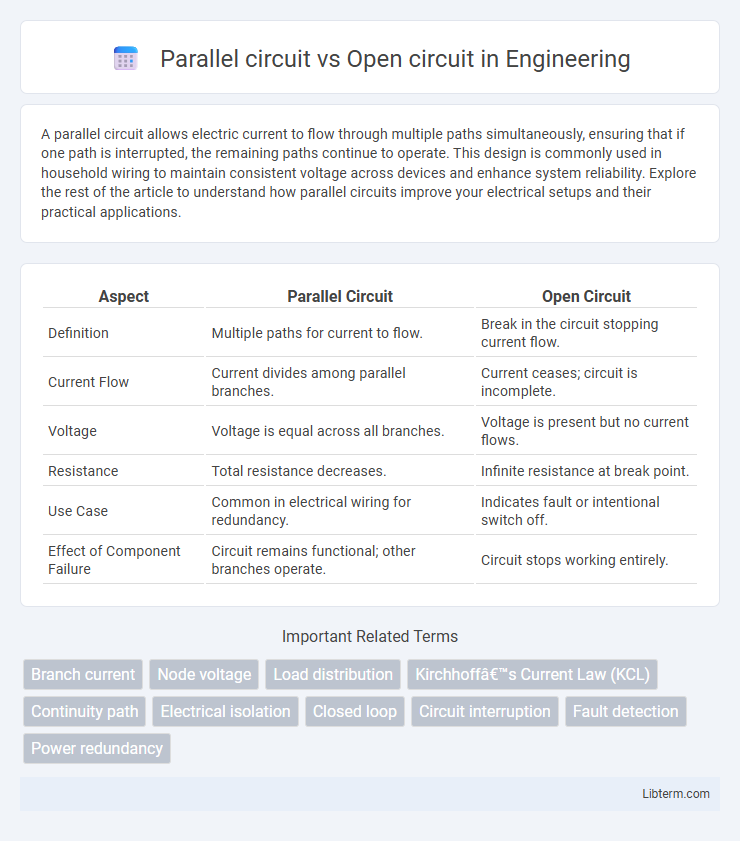A parallel circuit allows electric current to flow through multiple paths simultaneously, ensuring that if one path is interrupted, the remaining paths continue to operate. This design is commonly used in household wiring to maintain consistent voltage across devices and enhance system reliability. Explore the rest of the article to understand how parallel circuits improve your electrical setups and their practical applications.
Table of Comparison
| Aspect | Parallel Circuit | Open Circuit |
|---|---|---|
| Definition | Multiple paths for current to flow. | Break in the circuit stopping current flow. |
| Current Flow | Current divides among parallel branches. | Current ceases; circuit is incomplete. |
| Voltage | Voltage is equal across all branches. | Voltage is present but no current flows. |
| Resistance | Total resistance decreases. | Infinite resistance at break point. |
| Use Case | Common in electrical wiring for redundancy. | Indicates fault or intentional switch off. |
| Effect of Component Failure | Circuit remains functional; other branches operate. | Circuit stops working entirely. |
Introduction to Parallel and Open Circuits
Parallel circuits consist of multiple branches where components are connected across the same voltage source, allowing current to flow through all paths simultaneously. In contrast, an open circuit occurs when there is a break or gap that prevents current from flowing, effectively stopping circuit operation. Understanding the voltage distribution and current flow distinguishes parallel circuits from open circuits in practical electrical applications.
Defining Parallel Circuits
A parallel circuit features multiple branches connected across the same two points, allowing current to flow through several paths simultaneously, which contrasts with an open circuit where the path is broken and no current flows. Each branch in a parallel circuit has its own independent voltage equal to the source voltage, ensuring that if one branch fails, others continue functioning. Parallel circuits are crucial in applications like household wiring and electronic devices to maintain consistent voltage and reliability.
Understanding Open Circuits
An open circuit occurs when there is a break or disconnection in a circuit path, preventing current flow and causing electrical devices to stop functioning. Unlike parallel circuits, which provide multiple pathways for current to flow, an open circuit interrupts the continuity, resulting in zero current regardless of the voltage applied. Understanding open circuits is essential for troubleshooting electrical faults and ensuring reliable circuit operation by identifying breaks or loose connections.
Key Differences Between Parallel and Open Circuits
A parallel circuit contains multiple paths for current flow, allowing electricity to pass through several branches simultaneously, whereas an open circuit has a break that interrupts the flow of current entirely. In parallel circuits, components operate independently, so if one path fails, others continue functioning; in an open circuit, the interruption stops all current flow, causing the entire circuit to be non-functional. The key difference lies in current flow continuity--parallel circuits maintain current distribution across branches, while open circuits stop current due to a disconnection or break.
Electrical Flow in Parallel Circuits
In parallel circuits, electrical flow divides into multiple paths, allowing current to flow independently through each branch while maintaining the same voltage across all components. This distribution ensures that a break or open circuit in one branch does not stop the flow of current in other branches, preserving functionality in the remaining paths. The overall current in the circuit is the sum of the currents through each parallel branch, enhancing system reliability and efficiency.
Electrical Flow in Open Circuits
In an open circuit, electrical flow is interrupted due to a break or disconnection, preventing current from passing through the entire circuit. Unlike parallel circuits, which provide multiple pathways for current to flow simultaneously, an open circuit halts current flow completely, resulting in zero voltage across the break. This interruption causes devices connected downstream of the break to lose power, highlighting the critical impact of circuit continuity on electrical function.
Advantages of Parallel Circuits
Parallel circuits provide consistent voltage across all components, ensuring that each device receives the full power supply voltage independent of others. This configuration allows individual components to operate independently, so a failure in one branch does not interrupt the entire circuit's functionality. Parallel circuits also offer easier scalability for adding or removing components without significantly affecting overall circuit performance.
Common Issues with Open Circuits
Open circuits often cause complete interruptions in electrical flow, resulting in devices or systems failing to operate. Common issues include broken connections, damaged wires, or faulty components that prevent current continuity, unlike parallel circuits where current can bypass individual branch failures. Troubleshooting open circuits typically involves inspecting for physical disconnections and testing circuit elements with a multimeter to restore continuity.
Applications of Parallel and Open Circuits
Parallel circuits are widely used in household electrical wiring, allowing multiple devices to operate independently without interrupting the entire system when one component fails. Open circuits find applications in safety mechanisms such as circuit breakers and switches, where the intentional break in the circuit stops current flow to prevent damage or hazards. Understanding the functional differences aids in designing reliable electrical systems for residential, industrial, and safety-critical environments.
Conclusion: Choosing the Right Circuit for Your Needs
Choosing the right circuit depends on the specific application and requirements. Parallel circuits are ideal for ensuring that individual components operate independently, maintaining functionality even if one path is broken. Open circuits are inherently non-functional for current flow and serve as a clear indication of incomplete or faulty circuits, making them useful for troubleshooting and safety purposes.
Parallel circuit Infographic

 libterm.com
libterm.com